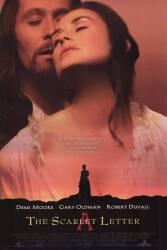Continuity mistake: Hester's estrange husband mistakenly kills a man at the end, and you see him cut his hair and his scalp off, then later when people find his body (after his suicide) his hair and scalp are intact. Then later you see him with the hair and scalp in his hands again.
Factual error: In the final trial scene, held outdoors in the town center, tribunal members who are on the raised platform are shown sitting by or leaning on tables spread with small, Persian-style carpets. It is likely that the set designer based this choice on an early American painting, which does include many subjects posing with furniture thus bedecked; however, the practice of laying a carpet on a table was employed only when posing for an artist's portrait under particular pricing terms set for a commission. Artists charged their rich patrons based on a scale of bodily detail. The more limbs, the greater the price. (You've no doubt heard the related expression 'to cost an arm and a leg.') A composition from the waist up would be more affordable, but would necessarily exclude a prized carpet, which was an icon of personal affluence. So, the artist adapted and cleverly laid an admired carpet on a desk or table to satisfy the vain, yet thrifty patron.





